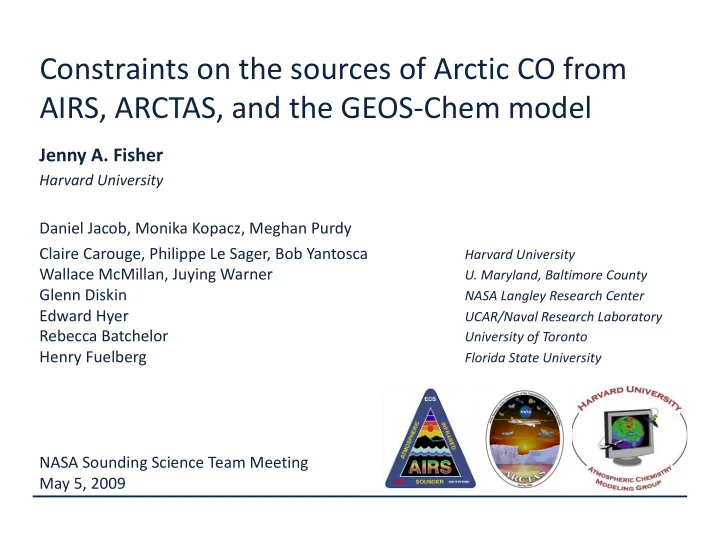

Constraints on the sources of Arctic CO from AIRS, ARCTAS, and the GEOS‐Chem model Jenny A. Fisher Harvard University Daniel Jacob, Monika Kopacz, Meghan Purdy Claire Carouge, Philippe Le Sager, Bob Yantosca Harvard University Wallace McMillan, Juying Warner U. Maryland, Baltimore County Glenn Diskin NASA Langley Research Center Edward Hyer UCAR/Naval Research Laboratory Rebecca Batchelor University of Toronto Henry Fuelberg Florida State University NASA Sounding Science Team Meeting May 5, 2009
GOAL: Assess pollution transport to the Arctic using AIRS combined with ARCTAS aircraft data and GEOS‐Chem model Motivation : Arctic is a known receptor of midlatitudes pollution, but sources and transport pathways are uncertain NOAA Approach : Integrated analysis of carbon monoxide (CO) from: 1. AIRS – Version 5 Level 2 CO columns, daytime observations only, gridded to 2°x2.5° model resolution 2. GEOS‐Chem – Chemical transport model (CTM), simulated CO is convolved with AIRS averaging kernels 3. ARCTAS – NASA aircraft campaign during April 2008, based in Fairbanks, AK Jenny Fisher NASA Sounding Science Team Meeting, 5/5/09
AIRS is a promising dataset for high‐latitude analysis Gridded AIRS CO column on 4/17/08 Substantial polar coverage on a daily basis Less inhibited by pervasive Arctic cloudiness than other satellite instruments High degrees of freedom for signal (DOFS), even in high latitudes (DOFS > 0.5 shown here) Promising for the Arctic, but how does AIRS CO compare to other satellite observations? Test with comparison via GEOS‐Chem CTM Jenny Fisher NASA Sounding Science Team Meeting, 5/5/09
AIRS CO column is generally consistent globally with other satellite data sets 4 DOFS 1.5 AIRS MOPITT TES 3 GEOS‐Chem CTM 2 1.0 1 r = 0.85 r = 0.81 r = 0.91 slope 0.71 slope 0.76 slope 0.88 0.5 300 4 SCIAMACHY SCIAMACHY GMD & (Bremen) (SRON) MOZAIC GEOS‐Chem CTM 3 200 2 100 1 r = 0.54 r = 0.82 r = 0.49 slope 0.62 slope 0.78 slope 0.82 1 2 3 4 1 2 3 •10 18 molec/cm 2 100 200 300 ppb Courtesy M. Kopacz Jenny Fisher NASA Sounding Science Team Meeting, 5/5/09
The datasets are less consistent and show higher biases in Northern Hemisphere spring Percent Difference (Data – Model) Highest AIRS vs. model difference in NH spring Higher AIRS vs. MOPITT discrepancy in NH Spring Most consistency of all instruments without spring data Courtesy M. Kopacz In general, the different instruments (especially AIRS & MOPITT) are consistent and all show a low bias in GEOS‐Chem, especially in spring. Jenny Fisher NASA Sounding Science Team Meeting, 5/5/09 Jenny Fisher NASA Sounding Science Team Meeting, 5/5/09
ARCTAS (2008) provided a unique dataset for polar analysis ARCTAS Arctic Research of the Composition of the Troposphere from Aircraft and Satellites Coordinated aircraft campaign (NASA + NOAA + DOE + Europeans + … ) Simultaneous intensive surface sampling Focus on validation of polar‐orbiting satellites, including AIRS Jenny Fisher NASA Sounding Science Team Meeting, 5/5/09
Intense, early fires in Russia led to high CO in April 2008 GEOS‐Chem CO emissions MODIS fire counts • = April Fire Pixel Counts 1σ mean 2002 2003 2004 2005 2006 2007 2008 NASA Goddard Earth Sciences Data and Information Services Center Jenny Fisher NASA Sounding Science Team Meeting, 5/5/09
GEOS‐Chem showed low bias relative to in‐situ observations GEOS‐Chem and aircraft profiles GEOS‐Chem and ground‐based FTIR columns at Eureka Jenny Fisher NASA Sounding Science Team Meeting, 5/5/09
GEOS‐Chem showed low bias relative to in‐situ observations GEOS‐Chem and aircraft profiles GEOS‐Chem and ground‐based FTIR GEOS‐Chem Source adjustments: columns at Eureka North American pollution 1.04 European pollution 1.39 Asian pollution 1.23 Russian biomass burning 0.21 Asian biomass burning 0.32 Jenny Fisher NASA Sounding Science Team Meeting, 5/5/09
Even with source adjustment, GEOS‐Chem is lower than AIRS throughout Arctic and midlatitudes AIRS GEOS‐Chem % Diff. ‐20 0 20 % Difference likely reflects known high bias in AIRS CO Largest bias over Russian fire region source adjustment too severe? Lowest bias over North American Arctic (i.e. ARCTAS region) Jenny Fisher NASA Sounding Science Team Meeting, 5/5/09
Recommend
More recommend